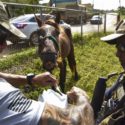Puppy dog rescues became a popular topic in social media conversations after Hurricane Maria, but what of the other animals on the Island? The effects of the hurricane on animals have affected humans, too.
Sound recordings begun last spring in various parts of the territory bring some good news. Listen to the file below to get a sense of how the hurricanes sounded to shrimp. The sound you hear at the beginning of the time-lapse recording is the normal sound of snapping shrimp. They go quiet during Hurricane Maria, but get busy again soon after.
https://soundcloud.com/user-629727076/snapping-shrimp-at-media-luna
Researchers say that things are back to normal among the shrimp, who don’t need the Island’s infrastructure to sustain life. The bioluminescent bay is beginning to glow again, too.
It’s different for cattle. Dairy farmers say that milk production dropped as much as 50% after the hurricanes, with continuing depletion of 10-20%. About 10% of Puerto Rico’s dairy farms went out of business after the hurricane, often because they did not have the electric power needed. Some farms lost too many of their cattle to continue.
However, there is an ironic situation with the Island’s dairy industry. There are just three milk processing plants for 250 dairy farms, and only one of the plants has the capacity to produce shelf-stable milk. With so many people still without electricity, shelf-stable milk is an important resource. Since there is only one processing plant that can produce it, farmers are being turned away when they try to send milk to be processed for shelf-stable milk. And yet, since there is a great local need, shelf-stable milk is being imported from the states.
Things are worse among Puerto Rico’s bees. Beekeepers report that 80-90% of Puerto Rico’s bee population was lost. This was the result not only of flooding and destruction of habitat, but also of the loss of flowers for bees to live on. Experts say that it could be several years before the bees return to their pre-hurricane numbers.
Mosquitoes, on the other hand, are doing fine. Standing water and interruptions in work aimed at controlling mosquitoes make it more likely that Puerto Rico will face outbreaks of Dengue fever and Zika virus this year.
These few examples have one big takeaway: the effects of Hurricane Maria are not limited to the obvious problems. Puerto Rico’s rebuilding has to be a systemic effort. We hope to see Puerto Rico rebuilt not only to pre-hurricane levels just in time for the next hurricane season, but rebuilt as the 51st state, with the protections statehood gives.








No responses yet